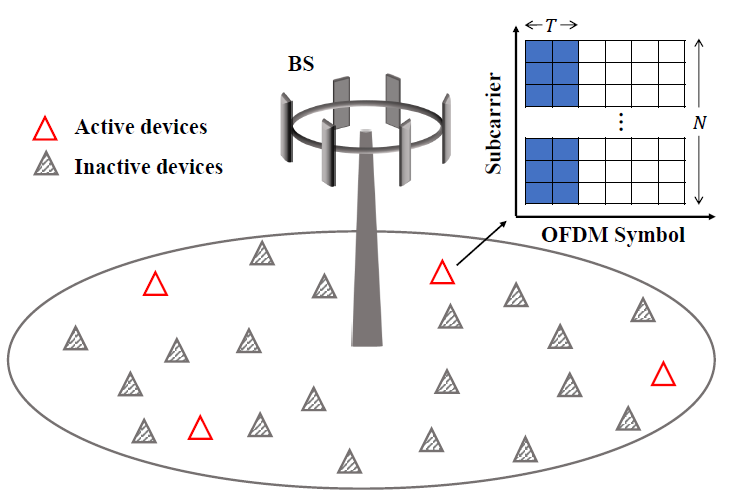System Model
MIMO-OFDM-Based Grant-free NOMA Model

The allocated bandwidth is used to support \(K\) single-antenna devices to randomly access an \(M\)-antenna base station (BS).
In each time instance, only a small subset of devices are active. To characterize such sporadic transmission, the device activity is described by an indicator function \(\alpha_k\) as
with \(p(\alpha_k = 1) = \lambda\) where \(\lambda\ll1\).
We adopt a multi-path block-fading channel (the multi-path channel response remain constant within the coherence time). Denote the channel frequency response on the \(n\)-th subcarrier from the \(k\)-th device at \(m\)-th BS antenna by
where \(\Delta f\) is the OFDM subcarrier spacing; \(L_k\) is the number of channel taps of the \(k\)-th device; \(\rho_{k,l}\) and \(\tau_{k,l}\) are respectively the \(l\)-th tap power and tap delay of the \(k\)-th device; \(\beta_{k, m, l} \sim \mathcal{C} \mathcal{N}\left(\beta_{k, m, l} ; 0,1\right)\) is the normalized complex gain and assumed to be independent for any \(k,m,l\).
The channel frequency response can be expressed in a matrix form as
Let \(a^{(t)}_{k,n}\) be the pilot symbol of the \(k\)-th device transmitted on th \(n\)-th subcarrier at the \(t\)-th OFDM symbol, and \(T\) be the number of OFDM symbols for pilot transmission. Then
we construct a block diagonal matrix $\Lambda_k\in \mathbb{C}^{TN\times N} $ with the \(n\)-th diagonal block being \([a^{(1)}_{k,n},...,a^{(T)}_{k,n}]\) , i.e.,
Assume the cyclic-prefix (CP) length \(L_{cp} \ge \tau_{k,l}, \forall k,l\). After removing the CP and applying the discrete Fourier transform (DFT), the system model in the frequency domain is described as
where \(Y \in \mathbb{C}^{TN\times N}\) is the observation matrix; \(N\) is an additive white Gaussian noise (AWGN) matrix with its elements independently drawn from \(\mathcal{C} \mathcal{N}(0,\sigma^2)\).
Define the time-domain channel matrix of the \(k\)-th device as \(\tilde{H}_k\in \mathbb{C}^{N\times M}\). Note that \(\tilde{H}_k\) can be represented as the IDFT of \(G_k\), i.e,
where \(F \in \mathbb{C}^{N\times N}\) is the DFT matrix. Similarly, \(G_k=F\tilde{H}\).
where \(\tilde{H}=[\tilde{H}^T_1,...\tilde{H}^T_K]^T\) is the channel matrix in the time domain.
Proposed Block-Wise Linear System Model
We divide the \(N\) continuous subcarriers into \(Q\) subblocks. In each sub-block \(q\), a linear function is used as the approximation of the channel frequency response:
where \(h_{k,q,m}\) and \(c_{k,q,m}\) represent the mean and slope of the linear function in the \(q\)-th sub-block, respectively; \(\Delta_{k,n_q,m}\) is the error term due to model mismatch; and \(l_q=(q-\frac{1}{2})N/Q\) is the midpoint of \(n_q\).
For the \(k\)-th device, we define the matrix \(H_k \in \mathbb{C}^{Q\times N}\) and \(C_k\in \mathbb{C}^{Q\times N}\) as
Define \(\mathbf{E}_{1}=\operatorname{diag}\left(\mathbf{1}_{N / Q}, \ldots, \mathbf{1}_{N / Q}\right) \in \mathbb{R}^{N \times Q}\) with \(\mathbf{1}_{N / Q}\) being an all-one vector of length \(N/Q\) and \(E2=\operatorname{diag}(\mathbf{d}, \ldots, \mathbf{d}) \in \mathbb{R}^{N \times Q}\) with \(\mathbf{d}=\left[-\frac{N}{2 Q}+1, \ldots, \frac{N}{2 Q}\right]^{T}\). Then
the block-wise linear approximation of the channel frequency response \(G_k\) is given by
where \(\Delta_k \in \mathbb{C}^{N \times Q}\) is the error matrix. Substituting (11) into (5), we obtain the block-wise linear system model as
where \(\mathbf{A}=\left[\boldsymbol{\Lambda}_{1} \mathbf{E}_{1}, \ldots, \boldsymbol{\Lambda}_{K} \mathbf{E}_{1}\right] \in \mathbb{C}^{T N \times Q K}\) and \(B=\left[\boldsymbol{\Lambda}_{1} \mathbf{E}_{2}, \ldots, \boldsymbol{\Lambda}_{K} \mathbf{E}_{2}\right] \in \mathbb{C}^{T N \times Q K}\) are the pilot matrices; \(H=\left[\mathbf{H}_{1}^{T}, \ldots, \mathbf{H}_{K}^{T}\right]^{T} \in \mathbb{C}^{Q K \times M}\) is the channel mean matrix; \(\mathbf{C}=\left[\mathbf{C}_{1}^{T}, \ldots, \mathbf{C}_{K}^{T}\right]^{T} \in \mathbb{C}^{Q K \times M}\) is the channel compensation matrix; \(W\) is the summation of the AWGN and the error terms from model mismatch as
- MIMO-OFDM-Based Connectivity Compensation Selectivity Frequencymimo-ofdm-based connectivity compensation selectivity selectivity compensation mimo-ofdm-based connectivity likeshop-nginx connectivity programming response connectivity programming external endpoint connectivity programming容器response lightning-fast connectivity environments experience connectivity 213g abc